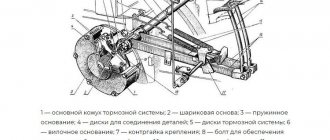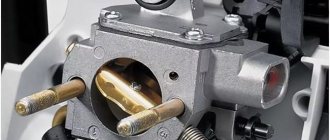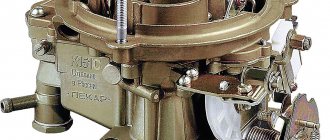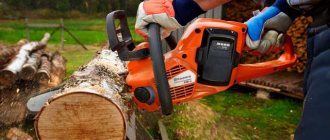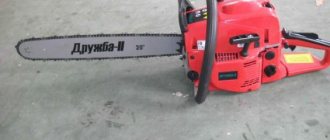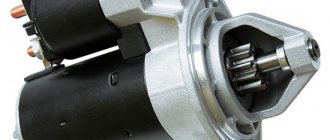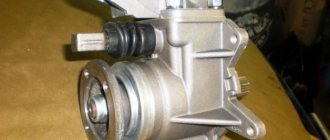The design of a chainsaw carburetor is simple and accessible
As with other chainsaw components, before repairing the carburetor, you should study its design in detail. This will help determine the true breakdown and quickly fix it. The design of a chainsaw carburetor consists of the following elements:
- Tube - equipped with a transverse damper that regulates the entry of air into the system;
- Diffuser – located next to the fuel inlet. As the diffuser narrows, the air flow rate into the system increases;
- Fuel needle - serves to distribute fuel;
- Float chamber - regulates the fuel level at the point of entry into the channel.
To better understand the design of the unit, you will need a diagram of a chainsaw carburetor. It clearly demonstrates the location and method of connecting the main elements of the unit.
The operating principle of a chainsaw carburetor is quite simple. The needle sprays fuel into the float chamber, after which the fuel is mixed with air. Next, the finished mixture enters the engine cylinder. The more fuel supplied to the engine, the higher the engine speed.
Regardless of the manufacturer and model of the chainsaw, each of the modern tools is equipped with carburetors that have an almost identical design and operate on the same principle. The main differences lie in the materials of the spare parts and their location in the carburetor structure.
Adjusting a chainsaw carburetor - when is the procedure required?
- The engine does not start at all, or stalls immediately after starting - the reason for this may be a shortage of fuel coupled with an excess of air;
- Increased fuel consumption - in this case, the amount of exhaust gases rapidly increases. The reason for this situation should be sought in an increase in the amount of fuel and a decrease in the amount of air;
There are also a number of mechanical reasons that lead to the need to adjust the carburetor. These include:
- Strong vibration - it leads to damage to the protective cap, resulting in loss of fixation of all three adjusting screws;
- Wear of the piston part of the engine - in such a situation, adjusting the carburetor will only temporarily prolong the operation of the tool. To completely eliminate the problem, you will have to completely replace the piston group;
- The formation of blockages - they appear as a result of the use of low-quality gasoline, damage to the filter or scale. In such cases, it will be necessary to dismantle, disassemble and clean the carburetor.
In any of the above cases, it is better not to delay the procedure for adjusting or flushing the unit. Otherwise, this will lead to damage to other equally important elements of the chainsaw.
How to properly adjust the carburetor on a chainsaw?
Before adjusting the carburetor on your chainsaw, you will need to learn the meaning of the three screws required for adjustment. These screws have certain markings and names:
- Screw “L” is necessary to adjust low speed;
- Screw “H” is required when tuning the motor to operate at high speeds;
- Screw "T" is needed to adjust the idle speed.
It is worth noting that some chainsaws are equipped with only one “T” screw, so the carburetors of such models are adjusted by manipulating only this screw.
No matter how many screws there are on the chainsaw, the factory carburetor settings are the most optimal for its operation. The screws themselves are initially used to configure the chainsaw to work in certain weather conditions.
The carburetors of chainsaws with three screws should be adjusted using screws “L” and “H”. To increase the speed, they should be turned clockwise. In order to lower the speed, the screws turn against it. To adjust the carburetor, you will need a special screwdriver for adjustment - it will not slip off the screws and damage the threads on their “caps”.
The carburetor adjustment process consists of two stages: initial and main. The adjustment algorithm is as follows:
- During the first stage, screws “L” and “H” must be tightened clockwise to the very end;
- After this, these screws need to be turned 1.5 turns in the opposite direction;
- At the second stage, you need to start the chainsaw and leave it for 10 minutes to completely warm up;
- Then start turning the screw “T” until the chainsaw motor starts to run stably and the chain on the bar does not rotate.
Basics
Don’t know how to disassemble a Partner chainsaw? After cleaning it with a compressor, follow the basic algorithm of actions:
- dismantling the brake chain cover;
- dismantling the saw set;
- removing the top cover;
- dismantling the handle of the device;
- starter disassembly.
This is the first step, it is recommended to complete it by re-cleaning (using the compressor again) the air duct, which may contain parts of wood dust that you did not get rid of during the first cleaning.
After this, dismantle:
- air filter housing;
- carburetor.
To prevent anything unnecessary from getting into the engine crankcase, the intake window cylinder is plugged with a rag.
Important! If desired, the muffler is removed immediately or after dismantling the carburetor.
At the last stage, the flywheel and clutch are removed using a piston stopper.
How to check a chainsaw carburetor?
After adjustment, you need to check the acceleration, maximum speed and engine idle. While checking the first parameter, you should sharply press the gas trigger. If the motor does not begin to gain speed, then you need to turn screw “L” counterclockwise. In this case, one turn should not exceed 1/8 of the full circle of the screw.
Read also: DIY rail cleaver
To measure the maximum revolutions, you will need to engage the “H” screw. To increase the maximum number of revolutions, the screw is turned clockwise. To reduce the indicator, the screw must be turned in the opposite direction. It should be remembered that the maximum speed should not exceed 15 thousand.
For a final check of the chainsaw while idling, you need to start the tool and place it on a level place. Let the engine warm up and pay attention to the following elements of the chainsaw:
- The chain should not move;
- Engine - when you press the gas trigger, it should confidently gain speed until the set maximum limit is reached.
An important tip is that if the carburetor is configured correctly, the sound of the chainsaw engine will closely resemble the sound of a 4-stroke engine.
The carburetor of a Chinese chainsaw is adjusted and checked in a similar manner. The only difference is that the process of setting up such tools can take much longer - on average, about an hour. In addition, it should be remembered that adjustment of Chinese chainsaws is required much more often - it often needs to be done immediately after running in a new tool.
Ignition faults
Most often, we think about repairs after the chainsaw stops starting, or visual signs of serious damage appear.
Signs of ignition malfunction:
- The chainsaw starts, but works unevenly (troits), often sneezes and shoots;
- The power of the chainsaw has noticeably dropped;
- When you sharply press the accelerator trigger, failures in engine operation are observed;
- The chainsaw does not start well when cold, it stalls violently until it warms up;
- Fuel consumption has increased significantly;
If such flaws appear in the operation of your chainsaw, then it’s time to diagnose, adjust, and possibly repair the ignition system.
Fault location determination:
First of all, it is necessary to inspect the spark plug; if a lot of carbon deposits have accumulated on it, then the cause of the malfunction is most likely related to the operation of the carburetor, piston group or fuel quality. If the spark plug visually appears to be in good working order, does not spark and is dry, make sure there is a spark.
- Unscrew the spark plug, put the ignition cable on it;
- Using insulated pliers, press the spark plug threads to the motor housing;
- Pull the starter handle sharply towards you and make sure there is a spark;
If there is no spark, replace the spark plug with a new one and test again. After making sure there is a spark, start the engine. But what to do if there is no spark even on a working spark plug? Let's continue the search:
We test the electrical cable for breaks and insufficient contact with the spark plug. We check the serviceability of the spring in the cap of the candle holder and the presence of contact with the armored cable;
To check the serviceability of electrical wiring, it is best to use a tester.
We check the gap between the ignition module and the flywheel magnetic circuit. It should be no more than 0.3 - 0.4 mm.
You can set the correct gap using a feeler gauge; they are not in short supply and are available for a small fee.
Diagnosing a fault with a multimeter
The malfunction of the ignition coil can also be determined using the so-called hardware method. However, for this you must have a multimeter with which diagnostics are carried out.
Step-by-step ignition diagnostics with a multimeter:
- We set the multimeter to a position where the arrow is at the 200 ohm mark.
- We study the instructions for the chainsaw. We find out the optimal resistance for the winding of the coil installed on our model (in most modern chainsaws this indicator ranges from 3-5 Ohms);
- We connect a multimeter to the primary winding of the coil and measure the resistance, if it is normal, we continue testing;
- We connect the multimeter to the secondary winding of the coil, compare the readings obtained with those indicated in the instruction manual;
- We connect the multimeter to the hole in the coil into which the wires are inserted. If the device produces normal readings, we come to the conclusion that the coil is working properly. If the measurement results are far from optimal, you will have to replace the assembly (coil) with a new one;
Video review of fault determination using a multimeter
As we have already noted, you can adjust the ignition system both in the workshop and at home. To do this, you will need ordinary wrenches, a screwdriver and a 0.4 mm feeler gauge (you can make a feeler gauge yourself from scrap materials - regular copier paper, a plastic bottle, etc.).
How to remove a carburetor from a chainsaw?
Before cleaning the carburetor or repairing it, this element of the chainsaw will need to be dismantled and disconnected from other components. To do this, you must follow a certain procedure. The dismantling algorithm looks like this:
- First, remove the top cover by unscrewing the 3 bolts around its perimeter;
- Remove the filter shaped like a foam pad;
- Disconnect the fuel supply hose;
- Remove the drive rod;
- Disconnect the cable end;
- Carefully remove and completely pull out the fuel supply hose.
Try to perform each action as carefully as possible. Otherwise, there will be a risk of damage to important elements of the chainsaw.
How to clean the carburetor on a chainsaw?
It is necessary to flush the carburetor of a chainsaw in cases where low-quality fuel is used to refuel the tool, or the tool is used at extremely low temperatures. During the work, you need to try not to damage or lose small parts of the assembly. Cleaning the carburetor is performed in the following order:
- Remove the screws holding the carburetor body;
- Open the lid, remove the small parts of the assembly and place them on a towel;
- Carefully treat the walls of the case and all existing parts with compressed air from a can;
- If carbon deposits remain on the parts, wipe them with a rag moistened with a degreaser;
- Dry the body and parts;
- Assemble and install the carburetor on the chainsaw.
The internal combustion engine of a chainsaw requires special attention due to harsh operating conditions, and this is especially true for the carburetor. Without periodic maintenance, no motor system will last long. Today we will talk about the process of adjusting and eliminating various malfunctions.
Chainsaw carburetor design
To independently adjust the carburetor of a chainsaw, you do not need to be a professional motor technician. However, you will still have to memorize some aspects of the carburetor’s operation regarding the process of preparing the fuel mixture.
The vast majority of chainsaws are equipped with Chinese-made Walbro carburetors. In their design they are simple, if not primitive. There is a monoblock pass-through type housing with a through hole. Inside the hole there is a diffuser - a narrowing of the passage with a fuel injection channel. There are valves on both sides: the smaller one is the throttle valve; it regulates the amount of fuel mixture supplied to the cylinder. The larger air damper serves to limit air flow during a cold start.
Walbro carburetor design: 1 - fuel inlet fitting; 2 - pulse channel of the membrane pump; 3 — inlet valve; 4 — fuel pump membrane; 5 — exhaust valve; 6 — filter mesh; 7 — air damper; 8 — throttle valve; 9 - fuel channel; 10 — idle speed adjustment screw; 11 - needle; 12 — idle jets; 13 - control membrane; 14 - fuel chamber; 15 - main jet; 16 — diffuser; 17 - main adjusting screw
All the magic of fuel preparation happens in the hidden channels and chamber of the diaphragm pump. When you turn the throttle valve, the cross-section of the channel through which fuel is injected into the mixing chamber increases slightly and fuel enters in a larger volume. In this case, the carburetor has two kinds of valves: for supply at low and high speeds. When changing the throttle position, the fuel flow changes proportionally between these two valves.
The need for such a device is that the quality of the mixture should be different at idle and under load. At the same time, the channel through which fuel is supplied to the mixer at idle does not close completely when the engine accelerates, and vice versa - the maximum speed channel is slightly undercut at idle.
Is disassembly necessary?
You can adjust the carburetor of a chainsaw without any disassembly at all; in rare exceptions, you only have to remove the air filter cover. There is a considerable amount of contradiction here: on the one hand, the chainsaw is designed for unhindered access to the adjustment mechanism, on the other hand, it is recommended to access it as little as possible.
Read also: Material for wood burning
True, experienced fellers and sawers always carry a flat-head screwdriver with a long blade and periodically adjust the carburetor. This is explained simply: during the manufacture of a chainsaw, its carburetor undergoes rough adjustments designed for a certain composition of air and fuel. It is clear that the conditions at the work site are different from those on the bench.
When changing the brand of gasoline or, for example, increasing air humidity, an experienced chainsaw user will always adjust the quality of the mixture for greater performance and less wear on the piston part. But this, we repeat, requires considerable experience in working with a specific chainsaw and knowledge of the peculiarities of its behavior. In addition, the adjustment is incredibly fine - the screws are tightened only 1/10. 1/20 turn.
Another reason for adjustment is carburetor repair or replacement. In any case, adjustment of the mixture quality should be carried out only if the serviceability of the carburetor is reliably known (no debris, gaskets are not poisoned), the air filter is clean, the spark plug, clutch and ignition system are in perfect order. Otherwise, there is a high probability that the malfunction will be eliminated in a moment and the adjustment will suddenly become incorrect, and the engine will begin to wear out.
Features of Patriot 4518
Among the features of the model, we can note the Easy Start system, which is implemented by installing an additional power spring in the starter. At the moment of start-up, the spring first accumulates force from the tension of the cable, then breaks off and turns the crankshaft. Thus, the engine resistance at start is compensated, and the user does not feel compression.
Also, the Patriot 4518 is equipped with a durable air filter that can be washed in gasoline and an automatic lubrication system that accurately doses the amount of oil necessary to reduce friction between the chain and the tire.
To facilitate the use of the chainsaw by inexperienced users, there are tips on the body informing the operator in what position the choke lever should be during cold and hot starts. This is, of course, a trifle, but sometimes it can save you from such troubles as a choked engine due to a violation of the starting algorithm.
Main adjustment screws
There are only three organs for adjusting the carburetor; these are screws shunted by springs for a flat-head screwdriver. There is a pair of screws at the bottom, L on the left, H on the right. A little higher is the T (or S) screw. So here's what they are for:
- Screw L is the same valve that regulates the cross-section of the fuel channel when operating at low speeds.
- Screw H, by analogy with the previous one, is a channel flow regulator for high speeds.
- Screw T is the throttle valve adjuster. It determines its position when the accelerator lever is fully released.
The design of the first two adjusting screws is extremely simple: at their ends there are needles inserted into spools of variable cross-section (cones). All threads are right-handed, so by tightening the screw clockwise, you drive the needle deeper and reduce the flow. When rotating counterclockwise, the exact opposite happens.
In this way, the quality of the mixture is regulated in different operating modes. If the fuel content increases, the gasoline does not have time to burn completely and the engine develops less speed. When the mixture becomes leaner, the speed, on the contrary, increases, and at the same time the engine temperature increases. It is worth noting that even when the screws are tightened all the way, the flow of both channels is not completely blocked, unless there is a blockage.
Regulation rules
The carburetor adjustment diagram and the recommended position of the adjusting screws are indicated in the instructions for each specific tool. When getting acquainted with a new saw, it is recommended to tighten the screws all the way, counting the number of revolutions, so that later you can return the factory settings. The general principles of adjustment are as follows:
- Before making adjustments, the engine must be warmed up at idle speed for 10 minutes.
- By rotating screw L, you need to achieve such a mixture quality that at idle the engine runs evenly at 1500–2000 rpm. In this case, acceleration (acceleration) when pressing the accelerator lever should be fast, but uniform. A dip in the speed increase indicates that the mixture is too lean; the screw must be unscrewed until this phenomenon disappears.
- After adjusting the low speed mixture, screw T is tightened until the chain begins to rotate, and then backed out 1/2. 1/3 turn. Here it is important to monitor the serviceability of the clutch mechanism.
- The H screw is not adjustable in makeshift conditions.
The danger of independently adjusting screw H is that too lean a mixture at high speeds, and especially under load, leads to rapid wear of the piston and failures in the ignition system. You can attempt to adjust high speeds only if three conditions are met:
- The chainsaw obviously does not produce the required power when cutting.
- The person performing the adjustment has general knowledge of carburetor engines.
- A means of measuring engine speed is available.
The latter can be either a tachometer or a multimeter with a built-in oscilloscope. To connect the multimeter, you need to wrap 3-4 turns of thin copper wire around the spark plug wire.
The main task of screw H is to compensate for over- or under-revving due to a change in fuel type, oil concentration or air composition. Also, the “upper” setting can be disrupted by insufficient precision in adjusting the low speed screw. The adjustment scheme is simple - the screw is tightened or unscrewed until the saw engine at maximum gas produces 14.5–15 thousand rpm or the value specified in the operating instructions.
If you use an oscilloscope, its readings (spark discharge frequency) should be in the region of 230–250 Hz. Take into account the accuracy class of the measuring instruments and the fact that under load the speed drops by 10–15%. It is better if the engine runs at low speeds than at high speeds, even if only slightly.
Operating Instructions: Starting
Quite often, after purchasing the equipment described, users wonder how to start a chainsaw. The first step is to set the chain brake to the non-working position. To do this, the brake handle moves forward. Then the fuel mixture must be poured into the neck of the fuel tank. Oil is poured into the chain lubrication tank. Containers for lubricant and fuel are marked with corresponding icons.
Now you can set the ignition to the appropriate position. The choke lever is fully extended. This will set it to the “Run” position. Now you should press the primer button several times. This will help fill the carburetor with the fuel mixture.
Place the chainsaw on a stable surface. In this case, the chain must rotate freely and be at a safe distance from surrounding objects. After reading the operating instructions for the Patriot-3816 chainsaw, you can understand that in the next step you need to hold the front handle by placing your right foot on the base of the rear handle. With your free hand, you can pull the starter handle. It should catch on.
Troubleshooting
As a conclusion, we will describe typical malfunctions associated with incorrect carburetor adjustment and methods for eliminating them:
- The engine does not start or starts and stalls after a few seconds. Obviously, the reason is the incorrect adjustment of the mixture quality at low speeds; it is too lean. If the carburetor is working properly, you need to enrich the mixture a little by unscrewing screw L 1/2 turn, and then complete the adjustment with screw T.
- The engine noticeably loses power under load. In this case, the carburetor produces a mixture that is too rich at high speeds. Screw H needs to be tightened 1/8 of a turn; if the engine load is still not sufficiently supported, but progress is noticeable, tighten it a little more.
- The engine “sings” at maximum acceleration without load. The mixture at high speeds is too lean, the speed is too high.
- The engine stalls if you apply gas after idling. The mixture is too lean or rich, or more precisely, you can tell by the condition of the candle.
Read also: What can be done with a glue gun
Please note that carburetor settings may be lost due to strong vibration. For this reason, a successfully selected adjustment must be remembered by counting the turns and position of each adjustment screw. If you have determined the best type of gasoline and oil ratio, save a small portion of this mixture so that in case of problems you can check whether the problems are related to the quality of the fuel and incorrect adjustment, or whether the cause is a malfunction of the chainsaw.
Reliable Chinese chainsaw Patriot PT 3816
Let's talk about the Patriot 3816 chainsaw, consider its purpose and characteristics. After reading the article, you will learn how to independently adjust the carburetor and troubleshoot problems that may occur in the chainsaw during operation.
IMPORTANT. An experienced electrician leaked the secret to the network on how to pay half as much for electricity legally. Read more
Video
You can learn how to set up the saw's carburetor in the video below. In this video, the master shows how to step-by-step adjust a Chinese-made chainsaw without using a tachometer. Conducts post-adjustment checks in various modes.
- Do-It-Yourself Chainsaw Carburetor Adjustment Caliber
Adjusting a chainsaw carburetor, although it looks like a fairly simple process, requires a very careful and responsible approach. The article describes the process in sufficient detail, but if you have never adjusted a chainsaw, you should turn to specialists, this will help save time, nerves and money.
HomeTips for buildersAdjusting a chainsaw carburetor. Or how not to pay repairmen!
Owning a chainsaw makes life easier even for an amateur in many ways, and in some professions this tool is actually indispensable. However, like any relatively complex device, a chainsaw requires periodic maintenance. Due to untimely or poor quality maintenance, as well as as a result of exposure to both planned and excessive loads, various types of malfunctions may appear. For professionals, interruptions or unstable operation of the saw reduce work efficiency or can cause a ruined work day. One of the quite common malfunctions is the incorrect setting of the chainsaw carburetor, which gets lost due to unsuccessful attempts at adjustment or displacement of the adjusting screws for other reasons.
Application of Patriot PT 3816
Patriot PT 3816 is a non-professional chainsaw model and is intended for private use. For example, Patriot 3816 will cope with tasks such as annual collection of firewood in small volumes, trimming tree branches in the garden, and reducing waste. In addition, the saw is used in fence construction to cut wooden posts.
The Patriot 3816 saw cannot be used by deforestation professionals due to resource constraints. The chainsaw parts are made well, but they are not designed to work in harsh conditions for long periods of time. The engine cylinder is entirely aluminum, which means it is resistant to long-term operation and even slight overheating. If the Patriot 3816 installs a chrome plated cylinder, the engine life will increase from time to time.
If you take a close look at the Patriot 3816, you will immediately see its resemblance to typical Chinese chainsaws.
We invite you to watch a video about the Patriot PT 3816 chainsaw, in which the owner shows the equipment and explains the main characteristics.
Modifications
The Patriot-3816 saw has been produced for quite a long time and has repeatedly undergone changes made to the design. The most significant modification can be considered the Imperial, which is produced on the same basis as the regular one and costs a little more. External differences include a different location of the oil tank neck, a different configuration of the start button, and the fastening of the cap with a wing nut rather than with clips. The bottom and side covers are also made of metal, which added almost a kilogram of weight to the saw. The inner surface of the cylinder is chrome plated.
Characteristics of Patriot PT 3816 and its description
The number 3816 is indicated in the marking, this means that the chainsaw has a 38 cm 3 engine and the bar length is 16 inches (40 cm).
This volume is enough to produce two horsepower, which together with 12,000 rpm gives good performance. The Patriot 3816 is equipped with a carburetor with the ability to adjust the quality of the mixture and a good air filter that, if necessary, can be washed in soapy water, and nothing will happen to it.
The slot width for installing the chain is 1.3 millimeters, the chain and drive sprocket have a pitch of 3/8 inch, the length of the chain. 57 links.
Owner reviews
Aidar, Kaliningrad:
“I’ve had this Patriot saw since 2012. I probably sawed a total of 120 cubes with it. About the fifth year of operation, the starter broke down and had to be replaced. BUT this is nothing compared to replacing chains. I replaced a lot of chains, I assume that at the beginning of operation, when there was no experience and no one around to tell me, I was doing something wrong. I like the Patriot chainsaw. I bought it for four thousand rubles, it’s good, it’s worth the money and it’s paid off for me a long time ago.
I didn’t identify any shortcomings in the Patriot, other than those already mentioned.”
